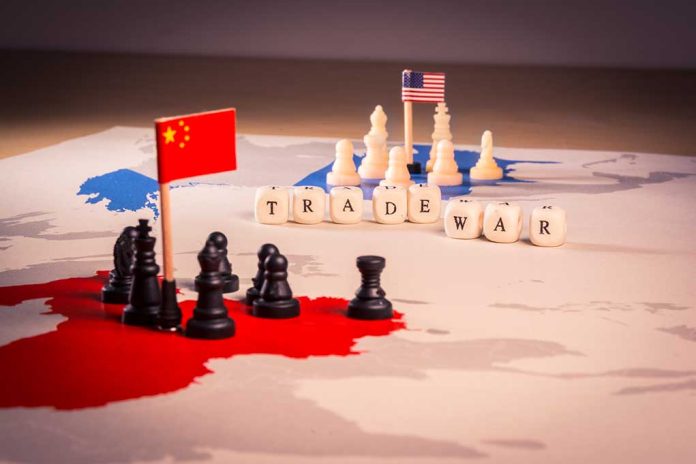
China strikes back with 84% tariffs on US goods, vowing to “fight to the end” as Trump’s 104% tariffs take effect, creating a serious escalation in the global trade war that threatens to disrupt global markets and supply chains.
Key Takeaways
- China has increased tariffs on US goods to 84% in retaliation to the Trump administration’s 104% tariffs on Chinese imports.
- Beijing has filed a formal complaint with the World Trade Organization and warned of additional countermeasures including restricting Hollywood films and banning US poultry imports.
- Trump has encouraged companies to relocate to the US to avoid tariffs, promising “ZERO TARIFFS” for those who manufacture domestically.
- The EU has approved retaliatory tariffs ranging from 15% to 25% on various US goods, effective next Tuesday.
- Global markets have been negatively impacted, with significant drops in European indexes as fears of a worldwide trade war intensify.
China’s Aggressive Response to Trump’s Tariffs
The Chinese government has dramatically escalated trade tensions by imposing an 84% tariff on American goods in response to President Trump’s new tariffs on Chinese imports. The Trump administration’s measures include a 50% tariff on Chinese goods, alongside existing 34% reciprocal tariffs, ultimately bringing the total to an unprecedented 104%. China has not only implemented countermeasures but has also formally filed a complaint with the World Trade Organization, signaling its intention to challenge the US actions through international legal channels.
Beijing’s foreign ministry has taken a hard line, with officials declaring that China will “fight to the end” in this trade dispute. This represents a more aggressive stance than during previous trade conflicts with the United States. The Chinese government has emphasized its determination to protect its economic interests, with Foreign Ministry spokesperson Lin Jian stating: “China will continue to take resolute measures to safeguard our legitimate and lawful rights and interests.”
104% tariffs on China are not enough. I'm advocating 400%. I do business with China. They don't play by the rules. They've been in the WTO for decades. They have never abided by any of the rules they agreed to when they came in for decades. They cheat, they steal, they steal IP.… pic.twitter.com/iotEgmNQrr
— Kevin O'Leary aka Mr. Wonderful (@kevinolearytv) April 9, 2025
Additional Countermeasures Being Considered
Beyond the announced tariff increases, Chinese state-linked commentators have outlined potential additional retaliatory measures that Beijing might implement. These include targeted increases on US agricultural exports like soybeans and wheat, which would directly impact American farmers in key electoral states. Other proposed measures involve banning imports of American poultry products, restricting Hollywood’s access to China’s massive film market, and suspending cooperation on fentanyl enforcement efforts—an issue the US has cited as partial justification for its tariff increases.
Chinese authorities are also considering tighter regulations on American companies operating within China, potentially complicating business operations for US firms that rely on the Chinese market. While Chinese officials have publicly maintained that economic decoupling is not their goal, these measures collectively suggest a willingness to accept greater economic separation if the trade conflict continues to escalate.
Global Implications and Market Reactions
The trade war’s impact extends far beyond just the US and China, with global markets reacting strongly to the escalation. European stock indexes have experienced significant drops as investors worry about disruptions to global supply chains and increased inflation pressures. The European Union has approved its own retaliatory tariffs against the US, ranging from 15% to 25% on various American goods, which will take effect next Tuesday. EU trade ministers are currently discussing a broader €25.7 billion tariff package on US goods.
While President Trump has claimed that China and other countries are eager to negotiate, with talks reportedly already beginning with Japan and South Korea, many foreign governments express confusion about the specific goals of these negotiations. One official from the Philippines told reporters: “Many of us have already written to them asking for meetings. We are all waiting for the reply.”
Trump’s Strategy and Domestic Manufacturing Push
President Trump has framed these tariffs as part of a broader strategy to bring manufacturing back to the United States. He has publicly encouraged companies to relocate their production facilities to America to avoid tariffs entirely, promising “ZERO TARIFFS” and “no environmental delays” for businesses that manufacture domestically. These tariffs come in addition to a 10% blanket tariff on all goods entering the US that took effect on April 5, creating a comprehensive approach to reshaping global trade flows in favor of domestic production.
The intensifying trade conflict represents a significant test for the global trading system that has prevailed for decades. With both the US and China appearing resolute in their positions and showing no signs of backing down, economists warn of potential long-term consequences including accelerated economic decoupling, disrupted supply chains, higher consumer prices, and increased inflation pressures. As both economic superpowers dig in for what China has termed a fight “to the end,” the international community watches with growing concern.









